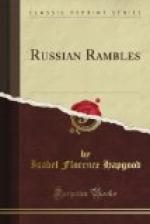The choicest “overland” tea—the true name is “Kiakhta tea”—can be had only by wholesale, alas! and it is the same with very many things. There are shops full of rolls of sarpinka, a fine, changeable gingham in pink and blue, green and yellow, and a score of other combinations, which washes perfectly, and is made by the peasants far down the Volga, in the season when agricultural labor is impossible. There are furs of more sorts than the foreign visitor is likely ever to have seen before; iron from the Ural mines by the ton, on a detached sand-spit in the Oka River; dried and salted fish by the cord, in a distant, too odorous spot; goldsmiths’ shops; old-clothes shops, where quaint and beautiful old costumes of Russia abound; Tatar shops, filled with fine, multi-colored leather work and other Tatar goods, presided over by the stately Tatars from whom we had bought at Kazan; shops piled with every variety of dried fruit, where prime Sultana raisins cost forty cents for a box of one hundred and twenty pounds. Altogether, it is a varied and instructive medley.
We learned several trade tricks. For example, we came upon the agency of a Moscow factory, which makes a woolen imitation of an Oriental silken fabric, known as termalama. The agent acknowledged that it was an imitation, and said that the price by the piece was twenty-five cents a yard. In the Moscow Oriental shops the dealers sell it for eight times that price, and swear that it is genuine from the East. A Russian friend of ours had been cheated in this way, and the dealers attempted to cheat us also,—in vain, after our Nizhni investigations.
Every one seemed to be absorbed in business, to the exclusion of every other thought. But sometimes, as we wandered along the boulevard, and among the rows, we found the ground of the Gostinny Dvor strewn with fresh sprays of fragrant fir, which we took at first to be a token that a funeral had occurred among some of the merchants’ clerks who lived over the shops. However, it appeared that a holy picture had been carried along the rows, and into the shops of those who desired its blessing on their trade, and a short service had been held. The “zeal” of these numerous devout persons must have enriched the church where the ikona dwelt, judging from the number, of times during our five days’ stay that we came upon these freshly strewn paths.
The part of the Fair which is most interesting to foreigners in general, I think, is the great glass gallery filled with retail booths, where Russians sell embroidery and laces and the handiwork of the peasants in general; where Caucasians deal in the beautiful gold and silver work of their native mountains; where swarthy Bokhariots sit cross-legged, with imperturbable dignity, among their gay wares, while the band plays, and the motley crowd bargains and gazes even in the evening when all the other shops are closed.




